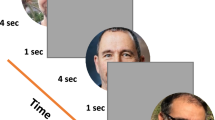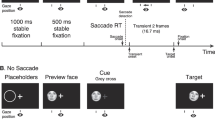Abstract
The spatio-temporal properties of saccadic eye movements can be influenced by the cognitive demand and the characteristics of the observed scene. Probably due to its crucial role in social communication, it is argued that face perception may involve different cognitive processes compared with non-face object or scene perception. In this study, we investigated whether and how face and natural scene images can influence the patterns of visuomotor activity. We recorded monkeys’ saccadic eye movements as they freely viewed monkey face and natural scene images. The face and natural scene images attracted similar number of fixations, but viewing of faces was accompanied by longer fixations compared with natural scenes. These longer fixations were dependent on the context of facial features. The duration of fixations directed at facial contours decreased when the face images were scrambled, and increased at the later stage of normal face viewing. The results suggest that face and natural scene images can generate different patterns of visuomotor activity. The extra fixation duration on faces may be correlated with the detailed analysis of facial features.






Similar content being viewed by others
References
Anderson JR (1998) Social stimuli and social rewards in primate learning and cognition. Behav Process 42:159–175
Andrew RJ (1963) Evolution of facial expressions. Science 142:1034–1041
Andrews TJ, Coppola DM (1999) Idiosyncratic characteristics of saccadic eye movements when viewing different visual environments. Vis Res 39:2947–2953
Bentin S, Allison T, Puce A, Perez E, McCarthy G (1996) Electrophysiological studies of face perception in humans. J Cogn Neurosci 8:551–565
Biederman I (1987) Recognition-by-components: a theory of human image understanding. Psychol Rev 94:115–147
Bruce V, Young A (1998) In the eye of the beholder. Oxford University, New York
Burton AM, Bruce V, Dench N (1993) What’s the difference between men and women? Evidence from facial measurement. Perception 22:153–176
Cootes TF, Taylor CJ, Cooper DH, Graham J (1992) Training models of shapes from sets of examples. In: Proceedings of British machine vision conference, pp 9–18
Cootes TF, Taylor CJ (1992) Active shape models, ‘Smart Snakes’. In: Proceedings of British machine vision conference, pp 266–275
Einhäuser W, König P (2003) Does luminance-contrast contribute to a saliency map for overt visual attention? Eur J Neurosci 17:1089–1097
Emery NJ (2000) The eyes have it: the neuroethology, function and evolution of social gaze. Neurosci Biobehav Rev 24:581–604
Epelboim J, Steinman R, Kowler E, Edwards M, Pizlo Z, Erkelens C, Collewijn H (1995) The function of visual search and memory in sequential looking tasks. Vis Res 35:3401–3422
Farah MJ (1996) Is face recognition ‘special’? Evidence from neuropsychology. Behav Brain Res 76:181–189
Fellous JM (1997) Gender discrimination and prediction on the basis of facial metric information. Vis Res 37:1961–1973
Field DJ (1987) Relations between the statistics of natural images and the response properties of cortical cells. J Opt Soc Am A 4:2379–2394
Gauthier I, Skudlarski P, Gore JC, Anderson AW (2000) Expertise for cars and birds recruits brain areas involved in face recognition. Nat Neurosci 3:191–197
Gauthier I, Tarr MJ, Anderson AW, Skudlarski P, Gore JC (1999) Activation of the middle fusiform ‘face area’ increases with expertise in recognizing novel objects. Nat Neurosci 2:568–573
Guo K, Benson PJ (1998) Involuntary eye movements in response to first- and second-order motion. Neuroreport 9:3543–3548
Guo K, Robertson RG, Mahmoodi S, Tadmor Y, Young MP (2003) How do monkeys view faces? – A study of eye movements. Exp Brain Res 150:363–374
Henderson JM (2003) Human gaze control during real-world scene perception. Trends Cognit Sci 7:498–504
Henderson JM, Hollingworth A (1999) High-level scene perception. Annu Rev Psychol 50:243–271
Henderson JM, Weeks PA, Hollingworth A (1999) Effects of semantic consistency on eye movements during scene viewing. J Exp Psychol Hum Percept Perform 25:210–228
Hooge IThC, Erkelens CJ (1998) Adjustment of fixation duration in visual search. Vis Res 38:1295–1302
Itier RJ, Taylor MJ (2004) N170 or N1? Spatial temporal differences between object and face processing using ERPs. Cerebr Cortex 14:132–142
Jacobs AM (1986) Eye-movement control in visual search: How direct is visual span control? Percept Psychophys 39:47–58
Johnson MH, Morton J (1991) Biology and cognitive development: the case of face recognition. Blackwell, Oxford
Kreyszig E (1999) Advanced engineering mathematics. Wiley, New York
Krieger G, Rentschler I, Hauske G, Schill K, Zetzsche C (2000) Object and scene analysis by saccadic eye-movements: an investigation with higher-order statistics. Spat Vis 13:201–214
Maurer D, Le Grand R, Mondloch CJ (2002) The many faces of configural processing. Trends Cogn Sci 6:255–260
McCarthy G, Puce A, Gore JC, Allison T (1997) Face-specific processing in the human fusiform gyrus. J Cogn Neurosci 9:605–610
Mendelson MJ, Haith MM, Goldman-Rakic PS (1982) Face scanning and responsiveness to social cues in infant rhesus monkeys. Dev Psychol 18:222–228
Moffit K (1980) Evaluation of fixation duration in visual search. Percept Psychophys 274:370–372
Moscovitch M, Winocur G, Behrmann M (1997) What is special about face recognition? Nineteen experiments on a person with visual object agnosia and dyslexia but normal face recognition. J Cogn Neurosci 9:555–604
Parkhurst D, Law K, Niebur E (2002) Modeling the role of salience in the allocation of overt visual attention. Vis Res 42:107–123
Parkhurst DJ, Niebur E (2003) Scene content selected by active vision. Spat Vis 16:125–154
Parr LA, Winslow JT, Hopkins WD (2000) Recognizing facial cues: individual discrimination by chimpanzees (pan troglodytes) and rhesus monkeys (macaca mulatta). J Comp Psychol 114:1–14
Perrett DI, May KA, Yoshikawa S (1994) Facial shape and judgements of female attractiveness. Nature 368:239–242
Pollatsek A, Rayner K, Balota DA (1986) Inferences about eye movement control from the perceptual span in reading. Percept Psychophys 40:123–130
Reinagel P, Zador AM (1999) Natural scene statistics at the centre of gaze. Network Comput Neural Syst 10:341–350
Rosenfeld SA, Van Hoesen GW (1979) Face recognition in the rhesus monkey. Neuropsychologia 17:503–509
Rossion B, Gauthier I (2002) How does the brain process upright and inverted faces? Behav Cogn Neurosci Rev 1:63–75
Rousselet GA, Mace MJ, Fabre-Thorpe M (2004) Spatiotemporal analyses of the N170 for human faces, animal faces and objects in natural scenes. Neuroreport 15:2607–2611
Ruderman DL, Bialek W (1994) Statistics of natural images: scaling in the woods. Phys Rev Lett 73:814–817
Salthouse TA, Ellis CL, Diener DC, Somberg BL (1981) Stimulus processing during eye fixation. J Exp Psychol Hum Percept Perform 73:611–623
Sergent J, Signoret JL (1992) Varieties of functional deficits in prosopagnosia. Cerebr Cortex 2:375–388
Sergent J, Otha S, MacDonald B (1992) Functional neuroanatomy of face and object processing. A positron emission tomography study. Brain 115:15–36
Simoncelli EP, Olshausen BA (2001) Natural image statistics and neural representation. Annu Rev Neurosci 24:1193–1216
Tanaka K (1997) Mechanisms of visual object recognition: monkey and human studies. Curr Opin Neurobiol 7:523–529
Tarr MJ, Cheng YD (2003) Learning to see faces and objects. Trends Cogn Sci 7:23–30
Tsao DY, Freiwald WA, Knutsen TA, Mandeville JB, Tootell RB (2003) Faces and objects in macaque cerebral cortex. Nat Neurosci 6:989–995
Turati C, Simion F, Milani I, Umiltà C (2002) Newborns’ preference for faces: what is crucial? Dev Psychol 38:875–882
van Diepen PMJ (1995) Chronometry of foveal information extraction during scene perception. In: Findlay JM, Walker R, Kentridge RW (eds) Eye movement research: mechanisms, processes and applications. Elsevier, North-Holland, pp 349–362
Valentine T (1988) Upside-down faces: a review of the effects of inversion upon face recognition. Br J Psychol 79:471–491
Yarbus A (1967) Eye movements and vision. Plenum, New York
Yin RK (1969) Looking at upside-down faces. J Exp Psychol 81:41–45
Young MP, Yamane S (1992) Sparse population coding of faces in inferior temporal cortex. Science 256:1327–1331
Acknowledgements
This work is supported by Wellcome Trust, HFSPO and EU FP5.
Author information
Authors and Affiliations
Corresponding author
Rights and permissions
About this article
Cite this article
Guo, K., Mahmoodi, S., Robertson, R.G. et al. Longer fixation duration while viewing face images. Exp Brain Res 171, 91–98 (2006). https://doi.org/10.1007/s00221-005-0248-y
Received:
Accepted:
Published:
Issue Date:
DOI: https://doi.org/10.1007/s00221-005-0248-y




